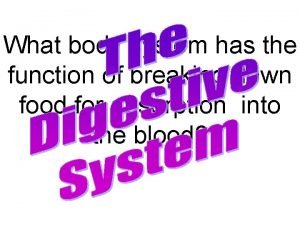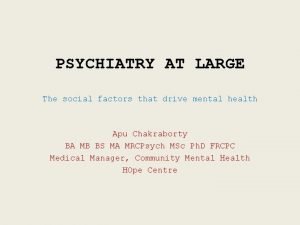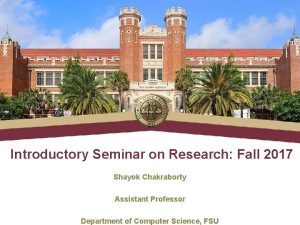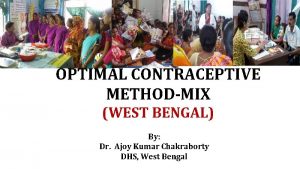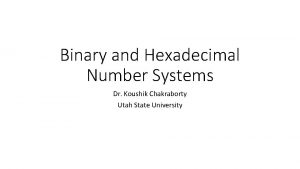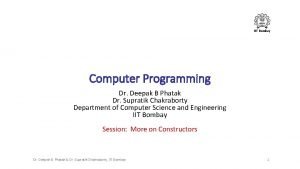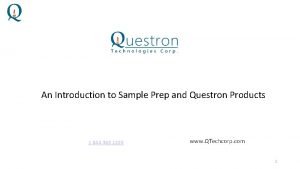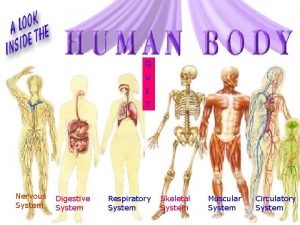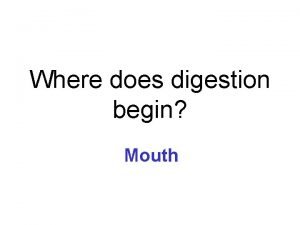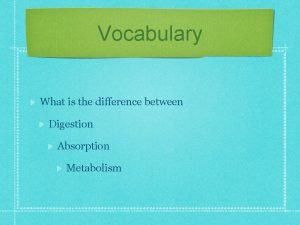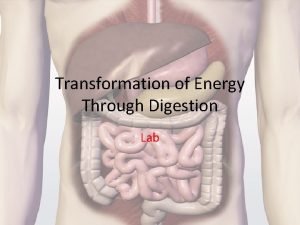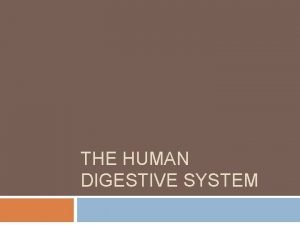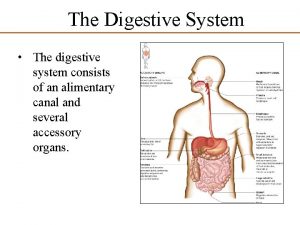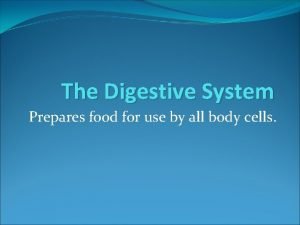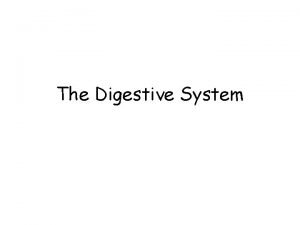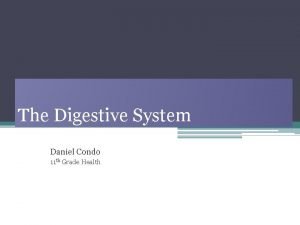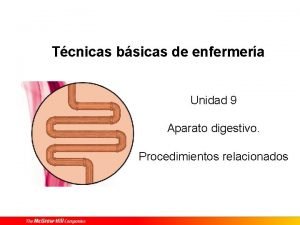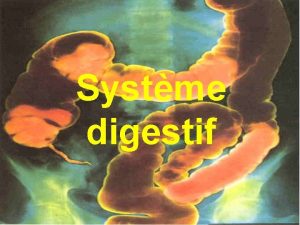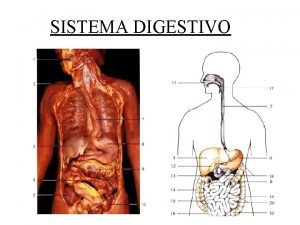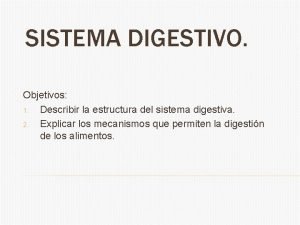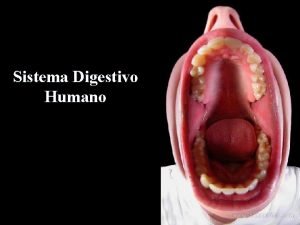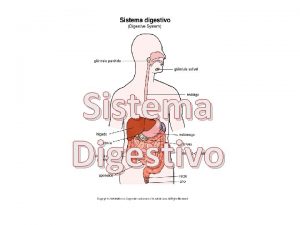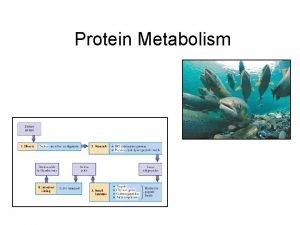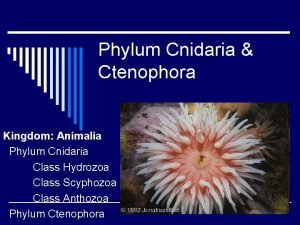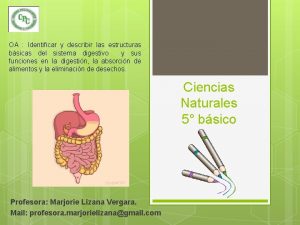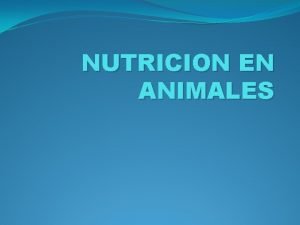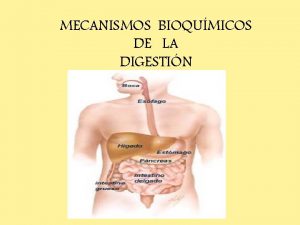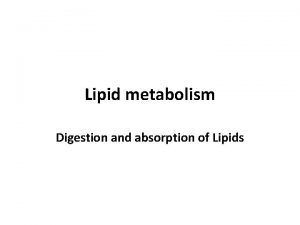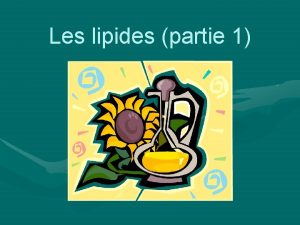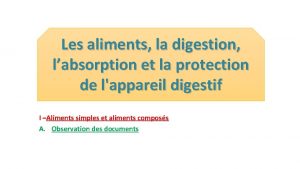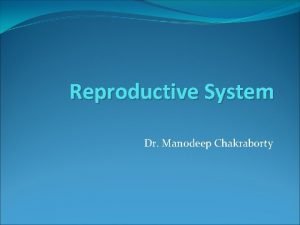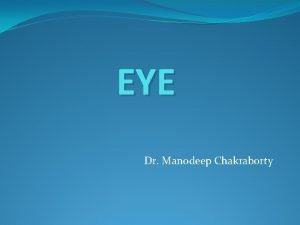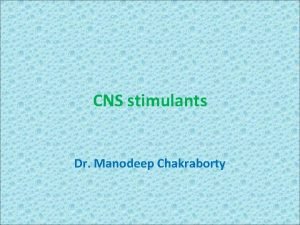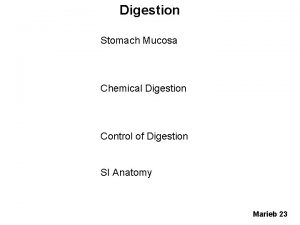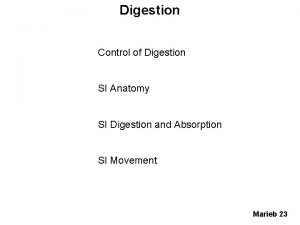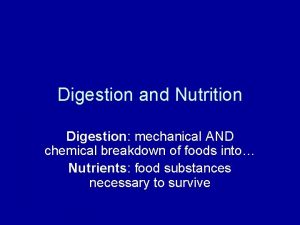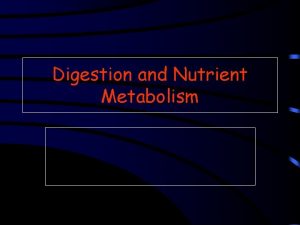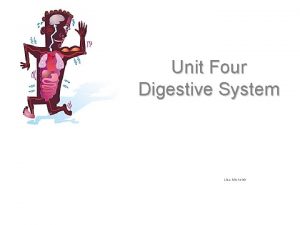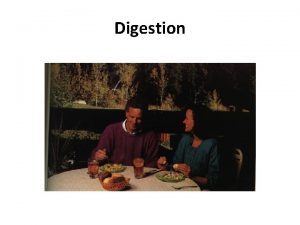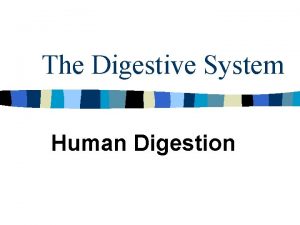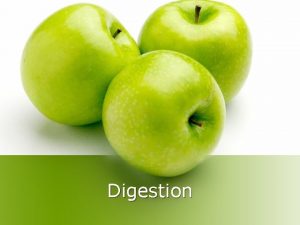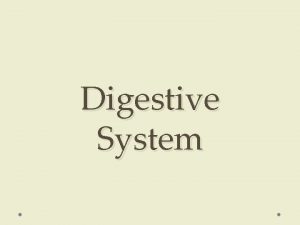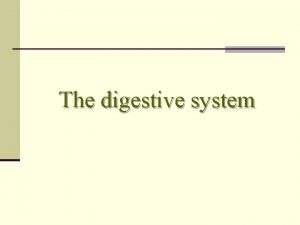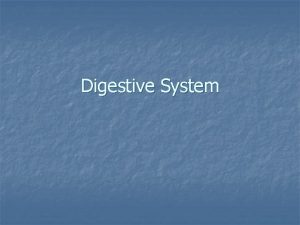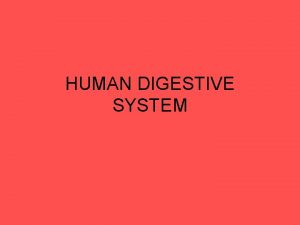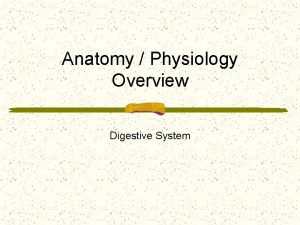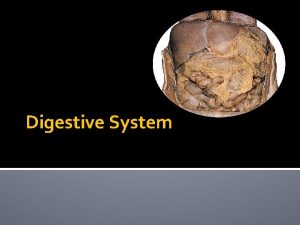Digestive System Dr Manodeep Chakraborty Digestion Digestive system

Digestive System Dr. Manodeep Chakraborty

Digestion Digestive system Functions of Digestive system Ingestion Propulsion Digestion Absorption Secretion Elimination Regulation of water balance Regulation of electrolyte balance Excretion

Organs of digestive system # Alimentary tract or GIT Mouth Pharynx Oesophagus Stomach Small intestine Large intestine Rectum & anal canal # Accessary glands/organs Salivary glands Pancreas Liver & biliary tract Gall bladder

Alimentary tract (GIT) Histology Adventitia or serosa Ø Parietal Ø Visceral Muscle layer Submucosa Mucosa lining Ø Mucous membrane Ø Lamina propria Ø Musculari’s mucosa

Nerve Supply Parasympathetic One pair of cranial, vagus, sacral nerves Sympathetic Spinal cord & lumbar region

Mouth Vestibule Palate Uvula Palatine tonsil

Tongue three varieties of papillae Vallate papillae Fungiform papillae Filiform Blood supply : Lingual branch of external carotid artery Nerve supply : Hypoglossal nerves (12) Lingual branch of mandibular nerves Facial & glossopharangeal nerves (7 & 9) Functions : Speech, Taste

Teeth Incisions Canine Premolars Molars Structure of teeth Bloods supply : Maxillary arteries & internal jugular vein Nerve supply : Trigeminal nerve (5) Maxillar & mandibular nerves

Salivary glands Types Parotid Submandibular Sublingual Structure of salivary glands Composition of Saliva water, minerals, salivary amylase, mucus, lysozyme, immunoglobulins, blood clotting factors Secretion of saliva Functions of saliva Digestion, lubrication, cleaning, nonspecific defense, taste

Pharynx Lining membrane (stratified squamous) Middle layer : Fibrous tissue Outer layer : Involuntary muscle

Different areas of abdominal cavity

Oesophagus Cricopharyngeal

Stomach Organs associated with the stomach Structure of stomach Walls of stomach Ø Four layer as that of alimentary canal Ø Muscle layer ü Congitudinal fibre ü Circular fibre ü Oblique fibre Mucosa Blood supply

Chyme Gastric juice Function Secretion of gastric juice Ø Cephalic phase Ø Gastric phase Ø Intestinal phase

Functions of the stomach Temporary storage Chemical digestion Mechanical digestion Absorption Defense Preparation of iron for absorption Production & secretion of intrinsic factor Regulation of the passage of gastric contents into the duodenum Secretion of the hormone gastrin

Small intestine Duodenum Jejunum Ileum Structure of small intestine Peritoneum Mucosa

Intestinal juice (15 oo ml) Composition water, mucus, mineral salts, enzymes, hormones Enzymes : Dipeptidase, Tripeptidase, Oligopeptidase, Aminopeptidase, Carboxypeptidase Carbohydrate digesting enzyme : Sucrase, maltase, iosomaltase, lactase Lipid digesting enzymes : Intestinal lipase, Cholesterol esterase, lecithinase Hormones : Enterogastrin, secretin, cholecystokinin Functions Peristalsis Secretion of intestinal juice Completion of chemical digestion of carbohydrates Protection against infection Secretion of cholecystokinin Absorption of nutrients Ø Chemical digestion in the small intestine

Pancreatic juice (1 -2 litres) Pancreatic juice Composition Ø Enzymes Solids Water (97. 5%) (2. 5%) Proteolytic enzymes Trypsinogen Organic Inorganic Chymotrypsinogen constituents Procarboxy peptidase Cations Anions Collagenase Na, K, Ca, Mg, Cl, SO 4, PO 4, Mn HCO 3 Elastase Nuclease – DNAase RNAase

Functions of pancreatic juice Digestion of protein (Trypsinogen & Chymotrypsinogen) Digestion of carbohydrate (Amylase) Digestion of fats (Lipase)

Bile (500 – 1000 ml) Composition Bile Water (97. 5%) Organic constituents Mucin Bile salts : Sodium taurocholate, Solids (2. 5%) Sodium glycocholate, Potassium taurocholate, Potassium glycocholate Inorganic constituents Cations Na, K, Ca, Mg, Mn Anions Cl, SO 4, PO 4, HCO 3 Bile acid : Cholic acid, Chenodeoxycholic acid Bile pigments : Bilirubin, Biliverdin, Urobilinogen, Stercobilin

Functions of bile Absorption of nutrients Ø Diffusion Ø Active transport

Large intestine Ø Cecum Ø Colon • Ascending • Transverse • Descending • Sigmoid Ø Rectum Ø Anal canal

Functions of the colon § Absorption, mass movement, microbial activity, defaecation Composition of faeces Faeces Water Solids Fibre, dead or live microbes, epithelial cells, fatty acids, mucus

Pancreas Exocrine Endocrine

Liver Portal tissue

Structure Of TS of liver

Functions Ø Carbohydrate metabolism Ø Fat metabolism Ø Protein metabolism Ø Production of heat Ø Secretion of bile Ø Storage of glucagon

Gall bladder Functions of the gall bladder Reservior for bile Concentration of the bile by upto 10 -15 fold Release of stored bile

Absorption of digested food Mechanism of absorptions are Ø Diffusion Ø Faciliated diffusion Ø Active transport Ø Vesicle mediated transport

Metabolism Catabolism Anabolism Metabolic rate Basal metabolic rate Central metabolic pathways Ø Glycolysis Ø Citric acid cycle Ø Oxidative phosphorylation

Metabolism of carbohydrate Metabolism of protein Metabolism of fat

Diseases of digestive system Diseases of mouth Acute ginivitis Tumour of mouth Diseases of salivary glands Diseases of oesophagus Mumps Calculus Oesophagitis Reflux oesophagitis Carcinoma Barrett’s oesophagus Achalasia Tumours Diseases of stomach Gastritis : Acute, Chronic Peptic ulceration : Acute, Chronic Tumours/gastric carcinoma Pyloric stenosis

Diseases of digestive system Diseases of intestine Appendicitis Microbial diseases : Cholera, Typhoid, Dysentry Disease of Pancreas Diseases of liver Diseases of gall bladder & bile ducts Pancreatitis (Acute & Chronic) Acute hepatitis Gallstones Cystic fibrosis Chronic hepatitis Jaundice Inflammatory bowel disease : Crohn’s disease, Ulcerative colitis, Tumours, Diverticular disease, Volvulus, Malabsorption Cirrhosis of liver Tumour of liver

Diseases of mouth Acute ginivitis Rare acute condition with severe ulceration of gums occurs that affect the lips mouth, throat, palatine tonsil Caused by Borrelia vincerti, Fusiform bacillus Diseases of salivary glands Mumps Acute inflammatory condition of salivary glands especially the parotid Caused by mumps virus

Calculus formation Crystallization of mineral salts in saliva Partially or completely block the ducts leading to swelling of the glands, a predisposition to infection and atrophy Diseases of oesophagus Oesophagitis Swallowing of caustic material, acquire fungal infection by immuno compromised people, viral infections e. g. Herpes simplex Sever injury, healing causes fibrosis, risk of development of oesophageal structure as the fibrous tissue shrinks

Reflux oesophagitis Indigestion or heat burn due to regurgitation of acidic gastric juice into oesophagus Irritation, Inflammation, Pain, Ulceration, Haemorrhage Reflux of gastric content is associated with increase in intraabdominal pressure e. g. in pregnancy, constipation & obesity High acidic content of gastric juice Low levels of secretion of hormone gastrin

Achalasia Peristalsis of the lower oesophagus is impaired Lower oesophageal sphincter fails to relax during swallowing causing dysphagia Regurgitationn of gastric content and aspiration pneumonia

Gastritis Either an excess of acid in the stomach or insufficient mucus to protect the surface epithlium Causes for gastrtis Prolonged use of NSAIDS Excessive alcohol consumption Food poisoning Ingestion of corrosive poisons, acid & alkalies Regurgitation of the bile into the stomach Helicobacter pylori

Peptic ulcer disease It is a circumscribed ulceration of mucus membrane penetrating through the muscularis mucosa & occurring in areas bathed by acid and pepsin in the stomach & duodenum. Gastric ulcer Duodenal ulcer Complications : Haemorrhage, Perforation, Gastric outflow obstruction, Development of malignant tumour
- Slides: 39
